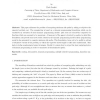Free Online Productivity Tools
i2Speak
i2Symbol
i2OCR
iTex2Img
iWeb2Print
iWeb2Shot
i2Type
iPdf2Split
iPdf2Merge
i2Bopomofo
i2Arabic
i2Style
i2Image
i2PDF
iLatex2Rtf
Sci2ools
101
click to vote
EOR
2006
2006
Dynamic programming and minimum risk paths
: This paper addresses the problem of computing minimum risk paths by taking as objective the expected accident cost. The computation is based on a dynamic programming formulation which can be considered an extension of usual dynamic programming models: path costs are recursively computed via functions which are assumed to be monotonic. A large part of the paper is devoted to analyze in detail this formulation and provide some new results. Based on the dynamic programming model a linear programming model is also presented to compute minimum risk paths. This formulation turns out to be useful in solving a biobjective version of the problem, in which also expected travel length is taken into consideration. This leads to define nondominated mixed strategies. Finally it is shown how to extend the basic updating device of dynamic programming in order to enumerate all nondominated paths.
Related Content
| Added | 12 Dec 2010 |
| Updated | 12 Dec 2010 |
| Type | Journal |
| Year | 2006 |
| Where | EOR |
| Authors | Paolo Serafini |
Comments (0)

